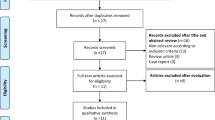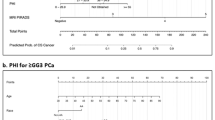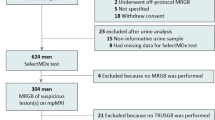Abstract
Background
The validated Stockholm3 test is used to improve PC detection. Stockholm3, however, was developed using systematic biopsies. We aimed to assess Stockholm3 operating performance when using MRI-targeted biopsies for PC detection.
Methods
A prospective cohort of 532 men was considered for prostate biopsy during 2016–2017. All men underwent Stockholm3 testing and MRI before biopsy. All PIRADs ≥3 lesion underwent targeted biopsy; all men underwent systematic biopsy. The primary outcome was ISUP Grade Group ≥2 (GG ≥ 2) PC. Detection strategies included: (1) systematic biopsies alone, (2) targeted biopsies alone, (3) targeted with associated systematic biopsies for MRI+, and (4) all biopsies in all men. For each strategy, the Stockholm3 operating characteristics were assessed with discrimination, calibration, and decision curve analysis (DCA).
Results
Median age was 65 years, median PSA was 6.2 ng/mL, median Stockholm3 score was 16.5%, and overall detection of GG ≥ 2 PC was 36% (193/532). Stockholm3 showed accurate discrimination for separating GG ≥ 2 cancer from benign and GG1, with an area under the curve of 0.84–0.86 depending on the biopsy strategy. Calibration analysis showed that Stockholm3 underestimated risks for GG ≥ 2 PC risk using MRI-targeted biopsies: there was a net benefit over biopsies in all men for Stockholm3 at risk thresholds varying from >3% in systematic biopsies to >15% in targeted with systematic biopsies in MRI+ men. When using a Stockholm3 score of >10% cutoff, a range of 32–38% of biopsies could be avoided while missing 5–11% of GG ≥ 2 PC and 0–3% of GG ≥ 3 PC.
Conclusions
Stockholm3 shows high discriminatory performance in an MRI-targeted biopsy setting, however risks are underpredicted due to MRI-targeted biopsies being more sensitive than the systematic biopsies for which Stockholm3 was developed. Stockholm3, along with any risk prediction model developed for systematic prostate biopsy decisions, will need recalibration for optimal use in an MRI-driven biopsy setting.
This is a preview of subscription content, access via your institution
Access options
Subscribe to this journal
Receive 4 print issues and online access
$259.00 per year
only $64.75 per issue
Buy this article
- Purchase on Springer Link
- Instant access to full article PDF
Prices may be subject to local taxes which are calculated during checkout



Similar content being viewed by others
Code availability
The code generated during the current study is available from the corresponding author on reasonable request.
References
Bray F, Ferlay J, Soerjomataram I, Siegel RL, Torre LA, Jemal A. Global cancer statistics 2018: GLOBOCAN estimates of incidence and mortality worldwide for 36 cancers in 185 countries. CA: Cancer J Clin. 2018;68:394–424.
Schroder FH, Hugosson J, Roobol MJ, et al. Screening and prostate cancer mortality: results of the European Randomised Study of Screening for Prostate Cancer (ERSPC) at 13 years of follow-up. Lancet. 2014;384:2027–35.
Etzioni R, Penson DF, Legler JM, et al. Overdiagnosis due to prostate-specific antigen screening: lessons from U.S. prostate cancer incidence trends. J Natl Cancer Inst. 2002;94:981–90.
Jansen FH, van Schaik RH, Kurstjens J, et al. Prostate-specific antigen (PSA) isoform p2PSA in combination with total PSA and free PSA improves diagnostic accuracy in prostate cancer detection. Eur Urol. 2010;57:921–7.
Vickers AJ, Cronin AM, Aus G, et al. A panel of kallikrein markers can reduce unnecessary biopsy for prostate cancer: data from the European Randomized Study of Prostate Cancer Screening in Goteborg, Sweden. BMC Med. 2008;6:19.
Leyten GH, Hessels D, Smit FP, et al. Identification of a candidate gene panel for the early diagnosis of prostate cancer. Clin Cancer Res: Off J Am Assoc Cancer Res. 2015;21:3061–70.
Ankerst DP, Straubinger J, Selig K, et al. A contemporary prostate biopsy risk calculator based on multiple heterogeneous cohorts. Eur Urol. 2018;74:197–203.
Roobol MJ, Verbeek JFM, van der Kwast T, Kummerlin IP, Kweldam CF, van Leenders G. Improving the Rotterdam European Randomized Study of screening for prostate cancer risk calculator for initial prostate biopsy by incorporating the 2014 International Society of Urological Pathology Gleason Grading and Cribriform growth. Eur Urol. 2017;72:45–51.
Deras IL, Aubin SM, Blase A, et al. PCA3: a molecular urine assay for predicting prostate biopsy outcome. J Urol. 2008;179:1587–92.
Ahdoot M, Wilbur AR, Reese SE, et al. MRI-targeted, systematic, and combined biopsy for prostate cancer diagnosis. N Engl J Med. 2020;382:917–28.
Kasivisvanathan V, Rannikko AS, Borghi M, et al. MRI-targeted or standard biopsy for prostate-cancer diagnosis. N Engl J Med. 2018;378:1767–77.
Gronberg H, Adolfsson J, Aly M, et al. Prostate cancer screening in men aged 50-69 years (STHLM3): a prospective population-based diagnostic study. Lancet Oncol. 2015;16:1667–76.
Eklund M, Gronberg H, Nordstrom T. The STHLM3 prostate cancer diagnostic study: calibration, clarification, and comments. Nat Rev Clin Oncol. 2016;13:394.
Gronberg H, Eklund M, Picker W, et al. Prostate cancer diagnostics using a combination of the Stockholm3 blood test and multiparametric magnetic resonance imaging. Eur Urol. 2018;74:722–8.
Barentsz JO, Weinreb JC, Verma S, et al. Synopsis of the PI-RADS v2 guidelines for multiparametric prostate magnetic resonance imaging and recommendations for use. Eur Urol. 2016;69:41–9.
Cox DR. Two further applications of a model for binary regression. Biometrika. 1958;45:562–5.
Steyerberg EW, Vergouwe Y. Towards better clinical prediction models: seven steps for development and an ABCD for validation. Eur Heart J. 2014;35:1925–31.
Van Calster B, Wynants L, Verbeek JFM, et al. Reporting and interpreting decision curve analysis: a guide for investigators. Eur Urol. 2018;74:796–804.
Mottet N, Bellmunt J, Bolla M, et al. EAU-ESTRO-SIOG guidelines on prostate cancer. Part 1: screening, diagnosis, and local treatment with curative intent. Eur Urol. 2017;71:618–29.
Mason BR, Eastham JA, Davis BJ, et al. Current status of MRI and PET in the NCCN guidelines for prostate cancer. J Natl Compr Canc Netw. 2019;17:506–13.
Porpiglia F, Manfredi M, Mele F, et al. Diagnostic pathway with multiparametric magnetic resonance imaging versus standard pathway: results from a randomized prospective study in biopsy-naive patients with suspected prostate cancer. Eur Urol. 2017;72:282–8.
Nordstrom T, Jaderling F, Carlsson S, Aly M, Gronberg H, Eklund M. Does a novel diagnostic pathway including blood-based risk prediction and MRI-targeted biopsies outperform prostate cancer screening using prostate-specific antigen and systematic prostate biopsies? - protocol of the randomised study STHLM3MRI. BMJ Open. 2019;9:e027816.
Alberts AR, Roobol MJ, Verbeek JFM, et al. Prediction of high-grade prostate cancer following multiparametric magnetic resonance imaging: improving the rotterdam european randomized study of screening for prostate cancer risk calculators. Eur Urol. 2019;75:310–8.
Palsdottir T, Nordstrom T, Aly M, et al. A unified prostate cancer risk prediction model combining the Stockholm3 test and magnetic resonance imaging. Eur Urol Oncol. 2019;2:490–6.
Parekh DJ, Punnen S, Sjoberg DD, et al. A multi-institutional prospective trial in the USA confirms that the 4Kscore accurately identifies men with high-grade prostate cancer. Eur Urol. 2015;68:464–70.
Lopes Vendrami C, McCarthy RJ, Chatterjee A, et al. The utility of prostate specific antigen density, prostate health index, and prostate health index density in predicting positive prostate biopsy outcome is dependent on the prostate biopsy methods. Urology. 2019;129:153–9.
Van Neste L, Hendriks RJ, Dijkstra S, et al. Detection of high-grade prostate cancer using a urinary molecular biomarker-based risk score. Eur Urol. 2016;70:740–8.
Wei JT, Feng Z, Partin AW, et al. Can urinary PCA3 supplement PSA in the early detection of prostate cancer? J Clin Oncol. 2014;32:4066–72.
Chiu PK, Ng CF, Semjonow A, et al. A multicentre evaluation of the role of the prostate health index (PHI) in regions with differing prevalence of prostate cancer: adjustment of PHI reference ranges is needed for European and Asian Settings. Eur Urol. 2019;75:558–61.
Vigneswaran HT, Discacciati A, Gann PH, Gronberg H, Eklund M, Abern MR. Ethnic variation in prostate cancer detection: a feasibility study for use of the Stockholm3 test in a multiethnic U.S. cohort. Prostate Cancer Prostatic Diseases. 2020.
Funding
Swedish Cancer Society (Cancerfonden) (Grönberg, Eklund, Nordström), Swedish Research Council (Vetenskapsrådet) (Grönberg, Eklund), Swedish Research Council for Health Working Life and Welfare (FORTE) (Eklund), Strategic Research Programme on Cancer (StratCan) (Nordström), and Swedish e-Science Research Center (SeRC) (Eklund).
Author information
Authors and Affiliations
Corresponding author
Ethics declarations
Conflict of interest
HG has five prostate cancer diagnostic-related patents pending, has patent applications licensed to Thermo Fisher Scientific, and might receive royalties from sales related to these patents. ME has five prostate cancer diagnostic-related patents pending. Karolinska Institutet collaborates with Thermo Fisher Scientific in developing the technology for the Stockholm3 test. The other authors declare that they have no conflict of interest.
Additional information
Publisher’s note Springer Nature remains neutral with regard to jurisdictional claims in published maps and institutional affiliations.
Supplementary information
Rights and permissions
About this article
Cite this article
Vigneswaran, H.T., Palsdottir, T., Olsson, H. et al. Biomarker discrimination and calibration with MRI-targeted biopsies: an analysis with the Stockholm3 test. Prostate Cancer Prostatic Dis 24, 457–464 (2021). https://doi.org/10.1038/s41391-020-00297-x
Received:
Revised:
Accepted:
Published:
Issue Date:
DOI: https://doi.org/10.1038/s41391-020-00297-x



